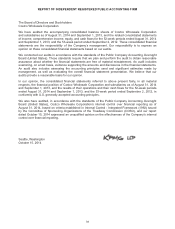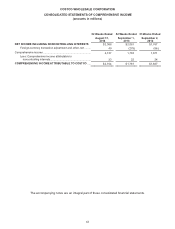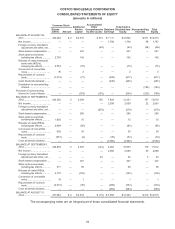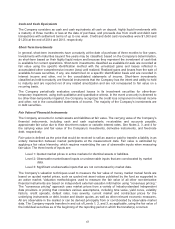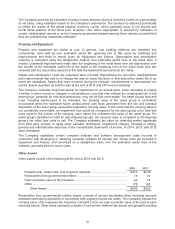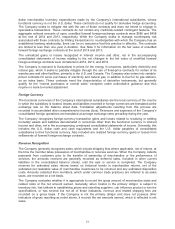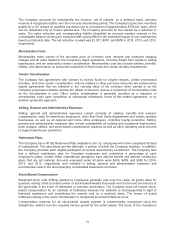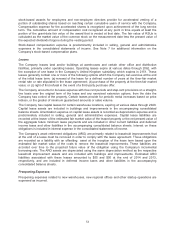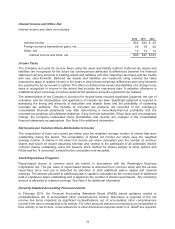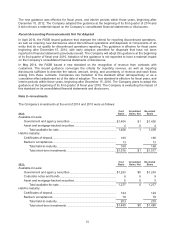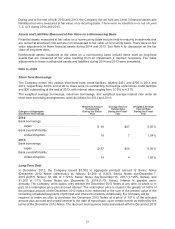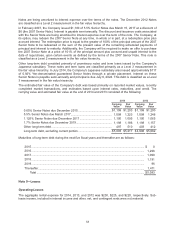Costco 2014 Annual Report Download - page 51
Download and view the complete annual report
Please find page 51 of the 2014 Costco annual report below. You can navigate through the pages in the report by either clicking on the pages listed below, or by using the keyword search tool below to find specific information within the annual report.
The Company provides for estimated inventory losses between physical inventory counts as a percentage
of net sales, using estimates based on the Company’s experience. The provision is adjusted periodically
to reflect the results of the actual physical inventory counts, which generally occur in the second and
fourth fiscal quarters of the fiscal year. Inventory cost, where appropriate, is reduced by estimates of
vendor rebates when earned or as the Company progresses towards earning those rebates, provided that
they are probable and reasonably estimable.
Property and Equipment
Property and equipment are stated at cost. In general, new building additions are classified into
components, each with its own estimated useful life, generally five to fifty years for buildings and
improvements and three to twenty years for equipment and fixtures. Depreciation and amortization
expense is computed using the straight-line method over estimated useful lives or the lease term, if
shorter. Leasehold improvements made after the beginning of the initial lease term are depreciated over
the shorter of the estimated useful life of the asset or the remaining term of the initial lease plus any
renewals that are reasonably assured at the date the leasehold improvements are made.
Repair and maintenance costs are expensed when incurred. Expenditures for remodels, refurbishments
and improvements that add to or change the way an asset functions or that extend the useful life of an
asset are capitalized. Assets that were removed during the remodel, refurbishment or improvement are
retired. Assets classified as held for sale at the end of 2014 and 2013 were immaterial.
The Company evaluates long-lived assets for impairment on an annual basis, when relocating or closing
a facility, or when events or changes in circumstances occur that may indicate the carrying amount of the
asset group, generally an individual warehouse, may not be fully recoverable. For asset groups held and
used, including warehouses to be relocated, the carrying value of the asset group is considered
recoverable when the estimated future undiscounted cash flows generated from the use and eventual
disposition of the asset group exceed the respective carrying value. In the event that the carrying value is
not considered recoverable, an impairment loss would be recognized for the asset group to be held and
used equal to the excess of the carrying value above the estimated fair value of the asset group. For
asset groups classified as held for sale (disposal group), the carrying value is compared to the disposal
group’s fair value less costs to sell. The Company estimates fair value by obtaining market appraisals
from third party brokers or using other valuation techniques. Impairment charges, included in selling,
general and administrative expenses in the consolidated statements of income, in 2014, 2013, and 2012
were immaterial.
The Company capitalizes certain computer software and software development costs incurred in
connection with developing or obtaining computer software for internal use. These costs are included in
equipment and fixtures, and amortized on a straight-line basis over the estimated useful lives of the
software, generally three to seven years.
Other Assets
Other assets consist of the following at the end of 2014 and 2013:
2014 2013
Pre
p
aid rents, lease costs, and lon
g
-term de
p
osits.................................................
.
$ 273
$ 236
Receivables from governmental entities ...................................................................
.
75
67
Cash surrender value of life insurance ......................................................................
.
80
74
Other ...............................................................................................................................
.
178
185
Other Assets ...........................................................................................................
.
$ 606
$ 562
Receivables from governmental entities largely consists of various tax-related items including amounts
deposited with taxing authorities in connection with ongoing income tax audits. The Company adjusts the
carrying value of its employee life insurance contracts to the net cash surrender value at the end of each
reporting period. Other assets primarily consists of non-current deferred tax assets and goodwill resulting
49


